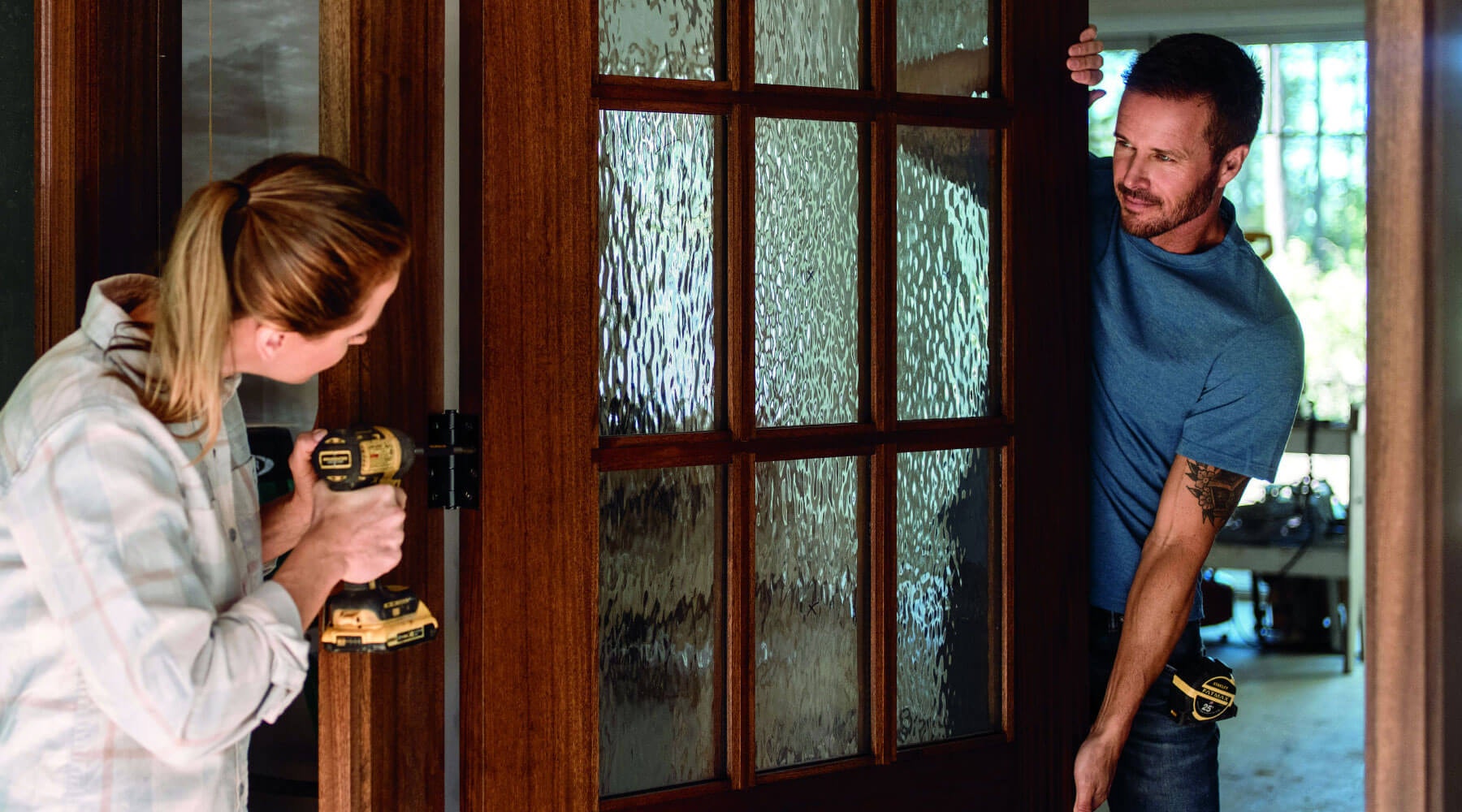How to Install a Front Door
Enhance your home with a new front door as you learn the general step-by-step process of full frame replacement entry door installation.

How Long it Takes:
1 day or more
Level of Difficulty
Intermediate to difficult
What You Need:
- Utility knife
- Pry bar
- Block of wood
- Pliers
- Hammer
- Power drill
- Drill bits
- Tape measure
- Reciprocating saw
- Flashing tape
- Shims
- Sealant gun and sealant
- Level
- Phillips and flathead screwdrivers
- Foam or fiberglass insulation
The front door replacement process is a step up from a DIY project like storm door installation. This is not a simple task for beginners. You need more tools, skills and experience for a quality installation.
Every home is unique. New front doors can have differences too. For this article, we’re sharing the general method of full frame replacement for a block frame fiberglass or steel entry door from Pella. This process involves removing the door panel and frame of the existing door from the wall, without disturbing the brick or siding.
The size, style, material and shape of the door — as well as whether your new door has brickmould or not — can impact the installation process. Before you get started, remove the plastic wrap and cardboard packaging from the door. Inspect the product for any damage and read your Pella entry door installation manual.
Step 1: Remove your current entry door
Before you can install a new front door, you have to remove the old one. In many older homes, doors are painted with lead-based paint. Removing the old door can disturb the paint, so you must take proper precautions to minimize exposure to dust and debris. Ask a certified risk assessor to check your home for lead paint hazards and help you choose your best removal options.
If your existing front door does not have lead-based paint, follow these steps for removing it:
- Remove the interior trim. Use a utility knife to score and scrape where it meets the wall to minimize any damage from pulling it off — especially if you plan on reusing the existing trim. Pry off the trim with a pry bar, using a block of wood for leverage. If you’re reusing the trim, pull out the nails through the back side of the trim with pliers. Do the same for the exterior trim.
- Take the door off the hinges. Hammer out the hinge pins to remove the door from the frame. Most hinge pins can be hammered out from the bottom.
- Remove the hinges. Unscrew the hinges from the frame. Use a power drill and a bit to get it done faster.
- Remove the fasteners. Pull out the nails or remove the screws that secure the door frame to the frame of the house. You may have to use a reciprocating saw to cut the nails or screws if you can’t easily get them out.
- Remove any shims. Inspect the door frame to see if there are any small pieces of wood that were used as shims to fit the old door.
- Take the door frame down. Carefully pull the old door frame off. You may have to pry it with a pry bar. Take caution not to damage the house as you pry the door frame.
Step 2: Prepare the rough opening
Clean and vacuum the rough opening of any debris from the entry door removal process. Cut and apply any metal flashing or drip cap per your Pella installation manual instructions. This may include flashing tape and sealants at the head, across the sill and six inches up each jamb to help create a tighter seal. For replacement projects, always be sure to resolve any water management issues or repair any wood deterioration that may exist within the wall system before installation of the new entry door.
Step 3: Set, square and plumb the door
This is where you’ll need some help. If your new door was ordered with brickmould, apply a continuous, 3/8-inch bead along the head and jambs, about a half inch from the opening. Add sealants or pan flashings on the opening sill in accordance with Pella installation instructions. Two or more people are needed to insert the new door frame, center it in place and plumb and square the door.
Place shims behind the vacant screw hole at each hinge until there is a consistent 1/8" gap between the hinge-side jamb and the door slab edge along the entire height of the door.
Squaring the Door
Square means that your corners meet at 90-degree angles. Use a tape measure and measure from one top corner across to the opposite bottom corner. Do the same from the other corner so you measure in an “X” pattern. If you get the same measurement, your door is square. Check it every time you shim or move the unit to be sure.
Plumbing the Door
Fasten a top corner of the frame to the rough opening and use a level to check the face of the frame, ensuring the door is straight up and down. When the door is square and plumb, the gap between the panel and frame should be consistent on all sides.
Step 4: Fasten your new front door
Carefully open the door and remove the spacers that kept the door closed in its packaging. Then secure the hinges to the stud by attaching the long screws provided through the open holes in the hinge.
Before moving onto the next step, make sure your door opens smoothly and evenly, and check for an even panel to frame reveal. Also, ensure all weatherstrips are properly in place and making contact with the door panel.
Step 5: Seal the door
From the inside of your home, seal the interior of the door with either insulating foam or backer rod and sealant. Backer rods help provide shape and depth for the sealant line you’re about to lay.
From the exterior of your house, for non-brickmould doors, insert backer rod 3/8 inches deep in the space around the door. Apply a bead of sealant around the entire perimeter. Apply another bead to the exterior edge of the sill and sill support. Use a putty knife to shape, smooth and clean any excess sealant. Add sealant near the frame corners, as indicated in the Pella installation instructions.
Step 6: Put on the finishing touches
You’re almost there. Your new front door is now set, fastened and sealed. Double check that everything is working properly by opening and closing the door a few times. All that’s left are a few things to make sure your new door looks as good as new. Check the assemblies and accessories in your installation manual for finishing touches. If you selected a different hardware set, install it by following the instructions on the set. Use a screwdriver to avoid damaging your new door. Factory finished door units do not require additional finishing, but you will want to read through the maintenance steps provided to ensure you know how to properly care for your new door.
Do-It-Yourself Front Door Installation
If all this sounds doable to you, shop for a new front door online from the comfort of your own space. This option allows you to measure, select and customize a door by yourself. Then, when it arrives, you can eliminate the cost to install a front door and put your new installation skills to the test by doing it yourself.
Professional Door Installation
Double doors, sidelights, transoms and other customized entry doors are more complex. Replacing an existing front door with a new style or combination may be more complicated. For any of these projects, professional installation is a worthwhile investment.
When you purchase a new front door through one of our Pella showrooms, you’ll benefit from expert help, start to finish. Leaving this project to a pro who is familiar with your product and the installation process will save you from spending an entire weekend replacing your entry door. Plus, you can rest assured knowing the door will be installed properly the first time. Find out what the entry door installation process entails when you choose to work with Pella professionals.


